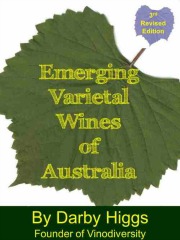Australian Wine from Alternative Grape Varieties |
|||
John Gladstones Viticulture and EnvironmentViticulture and Environment by John Gladstones
This book is out of print. But you can get Gladstones 2011 Book which
updates much of the material in the 1992 publication reviewed here.
The subtitle is of John Gladstones work is very informative. It reads
Gladstones points out that he deliberately uses the term qualities rather than the term quality, emphasising the multifacited nature of wine quality. Although this book was published over a decade ago it still exerts enormous influence over the Australian wine scene. My copy is the fifth reprint. John Gladstones was an Agronomist with the Western Australian Department of Agriculture whose main duties involved the breeding of lupins. After joining the Faculty of Agriculture at the University of Western Australia he became influential in the establishment of viticulture in new areas of Western Australia. During the 1960s he identified Margaret River as a site for a premium wine region, a prediction that has been totally vindicated.
The enduring influence of the book is assured because it sets out, with remarkable clarity, why it is that some regions consistently make better wine than others. While it deals chiefly with the Australian environment the principles and conclusions can be applied to all parts of the vinosphere. John Gladstones' scientific training shines through on every page. He enumerates the various hypotheses about the matter at hand. He then examines each one in the light of empirical evidence and established scientific theory. The hypothesis with the most evidence in its favour is adopted and the practical implications are spelt out. Viticulture and Environment begins with a chapter on the history of climate selection for Australian viticulture. This includes a discussion on the various methods of classifying climatic data. He then discusses in considerable detail the influence of individual climatic factors on grape quality. The subheadings in the chapter on individual climatic factors is illustrative of the depth of research and experience that has gone into this work. This chapter includes sections on Ripening period mean temperature; Mean temperatures and vegetative growth; Mean temperatures and vine fruitfulness; Soil temperatures and the roles and interactions of cytokinins; Continentality; Temperature variability; Sunshine hours; Light quality; Rainfall and its seasonal distribution; Relative humidity and saturation deficit; Windiness; Optimum combinations of climatic factors. Further chapters include Soil type and topography; Management practices and their interactions with environment; Predicting maturity date, and Maturity groupings of wine grape varieties. The second half of the book consists of climatic tables for 175 stations in the wine regions of all the Australian states and of the wine regions in each of the major wine growing regions of New Zealand, France, Germany, Central and Eastern Europe, Italy, Portugal, Spain, Madeira, England and the United States. Each table consists of eighteen columns of data of relevant viticultural climatic information and an estimate of the vintage date for the various varietal maturity groups. Commentary accompanying each group of tables point to any anomolies and local adjustments that may be required. Unfortunately this book is out of printYou may wish to see these related books Vines for Wines A Wine Lover's Guide to the Top Wine Grape Varieties By George Kerridge & Angela Gackle Or By Geoff Cox The book is concluded with a discussion of climate change and viticulture, appendices on plant hormones and data sources, a comprehensive list of references and four useful indexes. The practical significance of this book is enormous. It is simply indispensible for any planning to establish a vineyard in Australia, or elsewhere in the worlld for that matter. For serious winelovers who really want to know why some wines and vintages are superior to others this book certainly is well worth seeking out. Although it deals with technical aspects of interpreting climatic data it is so well written that it is a pleasure to read. It could serve as an exemplar of what good scientific and technical literature is all about, clarity of thought, clarity of explanation and crisp prose. John Gladstones' Viticulture and Environment was awarded Special Distinction in Viticulture by the Office International de Vigne et du Vin in Paris 1994. You can order a copy of Gladstones' Viticulture and environment online here. See more wine books reviewed here
|
Now available for delivery in Australia, and internationally
Get a free eCookbook "10 dishes for Sangiovese" Subscribe to the Vinodiversity Newsletter using the box below 
|
||
|
|
|||
|
Copyright©
Vinodiversity 2009.
Return to top |
|||



